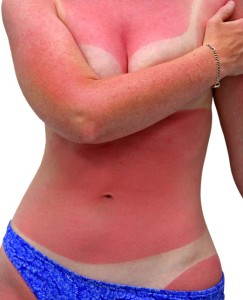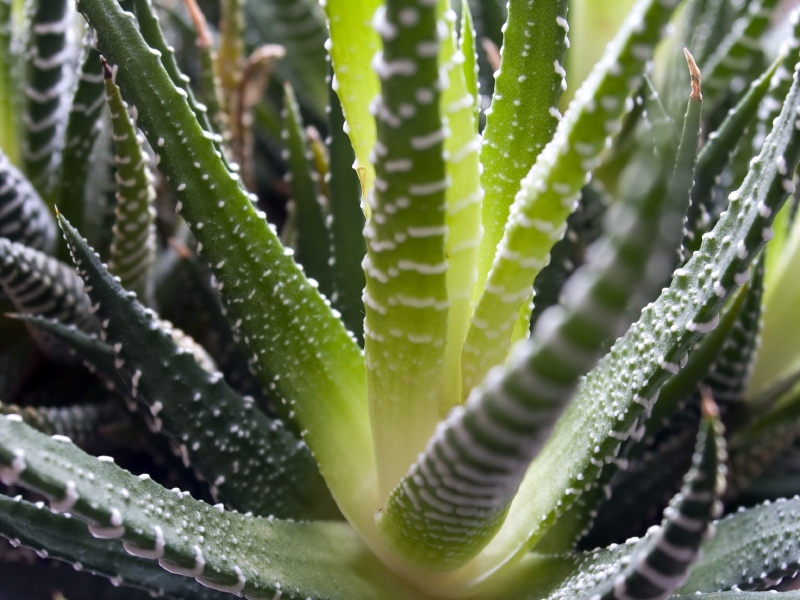The best treatment for sunburn is prevention. This is especially true for  people with little natural protection and fair skin that burns and freckles easily. This is stating the obvious, but it’s always worth repeating.
people with little natural protection and fair skin that burns and freckles easily. This is stating the obvious, but it’s always worth repeating.
Avoid direct contact with the sun during the hours when the sun is strongest: from 10:00 am to 2:00 pm. Some sources say until 4:00 pm.
Use both sunscreens with a sun protection factor (SPF) of 30 to 50. I hate the stuff, but it works if applied correctly. Create a significant coat, rub it into the skin, and reapply as directed otherwise it may fail to provide the rated SPF protection. Find a sunscreen that feels and smells good so that you use it. There’s no sense in carrying it around if it isn’t used or washed off right away. (see the Mayo Clinic for good advice on sunscreen use.)
Wear clothing that covers your skin and has sun protection. Nowadays, one can buy clothes made from extremely light, cool, wicking fabrics with considerable ultraviolet radiation protection. And, there’s the added benefit of feeling cooler and dryer. The highest ultraviolet protection factor (UPF) for clothing is +50, which blocks out 98% of the UV radiation that hits the surface of the clothing. Most stores that sell outdoor recreation gear offer a good range of options.
Sunburn Relief
So, if you haven’t used your sunblock or sported clothes with sun protection, and you get overexposed or sunburned, here are a couple of all-natural aromatherapy for sunburn relief suggestions.
IMPORTANT NOTE: This blog does not deal with severe sunburns that are characterized by significant skin blisters, infection, severe pain, and high fever. In such cases, consider seeking conventional medical attention.
The treatment of sunburns is a bit different than it is for overexposure. The latter is less severe, yet still damaging to the skin, so the treatment focus is more on skin nourishment, moisturizing, and restoration (overexposure can damage skin cells). Sunburned skin will benefit from nourishment, moisturizing, and restoration too, but it also requires immediate relief such as reducing inflammation and cooling.
While most people focus on sunburns, overexposure is more common and what people often ignore. If it isn’t painful and glaringly obvious, people often do nothing. But, even in these cases, treatment is beneficial.
Aloe Vera

I find aloe vera (Aloe barbadensis) to be extremely helpful for the immediate treatment of burns, and it’s better than any other carrier I’m aware of. Aloe is absorbed quickly and it soothes, moisturizes, and cools.
Some people might say: ‘Now, wait, aloe vera is not an essential oil so how is that aromatherapy?’ Well, carriers are a very important ingredient in aromatherapy applications, and specific carriers, such as aloe, contribute significant healing properties themselves. A good aromatherapist will pay attention to the carriers in addition to the selected essential oils. For me, aloe vera is the best carrier for burns.
Aloe even works wonders on kitchen burns. It’s an anti-inflammatory and a mild astringent: excellent properties to address burns. It’s also good for skin irritations, insect bites, and bee stings. Aloe is a great remedy for many summertime issues.
It’s an excellent addition to a household first aid kit. Keep a bottle or tube in the refrigerator to prolong its shelf life, to have it handy, and to give your skin an extra wonderful cooling sensation upon contact. Alternatively, keep a plant in the kitchen. Snip a piece off and squeeze the gel out when needed.
Carriers for Sun-Damaged Skin:
We’ve already noted that aloe vera is the best carrier for sunburned skin. For overexposed skin, there are many additional nourishing, moisturizing, and restorative options because the skin is less sore and damaged. When the skin feels sore or sensitive, I start with aloe and then switch to other carriers and applications when the soreness abates. Some good choices for carriers are:
- Avocado oil (Persea americana)
- Baobab oil (Adansonia digitata)
- Borage seed oil (Borago officinalis)
- Calendula macerated (infused) oil (Calendula officinalis)
- Carrot macerated oil (Daucus carota)
- Cocoa butter (Theobroma cacao)
- Hazel nut oil (Corylus avellana)
- Jojoba (Simmondsia sinensis)
- Kutui nut oil (Aleuites moluccans)
- Rose hip oil (Rosa canina)
- Shea butter (Butyrospermum parkii)
- Sunflower oil (Helianthus annuus)
- Wheat germ oil (Triticum vulgare)
Oils tend to be absorbed quickly – each has its own rate of absorption. Butters are thicker and remain on the skin longer, prolonging their contact with the skin surface and the healing process. All of these carriers can also be used to make stovetop lotions and creams. Lotions contain more water than creams and are, therefore, lighter and more readily absorbed. Since they contain water, they oxidize and go off more quickly than creams.
IMPORTANT NOTE: Some carriers should not be used at full strength, and should be mixed with other carriers. For example, rose hip and calendula should be kept to less than 20% of the total carrier blend. Kutui nut and wheat germ shouldn’t exceed 10%. Obviously, nut oils should not be used by those with nut allergies and wheat germ oil shouldn’t be used by those with wheat allergies. Check for standard restrictions before choosing the carriers.
Despite this caution and the restrictions on percentage concentration, all of these carriers have wonderful moisturizing and restorative properties. Adding a small amount to other carriers can still enhance the treatment with the specific carrier’s unique attributes.
What I do is make up a skin-soothing, skin-healing body butter and leave it in the refrigerator until I need it. I use body butter for overexposure because I focus on nourishing and rehabilitating the skin. Butters are rich and penetrating and homemade butters can be made according to one’s preferred consistency.
Essential Oils for Overexposure
Add essential oils to aloe vera, carrier oils, or butters for greater relief and to enhance healing properties. Consider:
- Australian blue cypress (Callitris intratropica),
- geranium (Pelargonium graveolens),
- everlasting (Helichrysum italicum),
- lavender (Lavandula angustifolia),
- Roman chamomile (Chamaemelum nobile),
- tea tree (Melaleuca alternifolia).
Use Both lavender and tea tree in a wide range of household remedies so they would be a more versatile and cheaper option than some of the other essential oils. Roman chamomile is safe and appropriate for children and babies. Although, dilute the essential oils more for babies (1% or less).
I always have pure aloe vera or aloe vera mixed with up to 2% essential oils (about 12 drops per ounce or 30 milliliters) readily available for immediate treatment. This is something anyone can easily organize for themselves and their families. (See our blog post for more information on proper dilutions.)
IMPORTANT NOTE: Some essential oils can cause skin irritation, especially if applied in too high of a concentration or too sensitive or oozing blisters or broken and already irritated skin.
Essential Oils of Dry and Damaged Skin
Sunburns imply skin damage, and overexposure without burning is still tough on the skin. For skin healing and rejuvenation, try the following essential oils:
- calendula (Calendula officinalis),
- carrot seed (Daucus carrota),
- cistus (Cistus ladanifer),
- lavender,
- everlasting,
- frankincense (Boswellia cateri),
- myrrh (Commiphora myrrha),
- niaouli (Melaleuca quinquenervia)
- palma rosa (Cymbopogon martinii)
- rosewood (aniba rosaeodora)
See our blog post on Essential Oils for the Summer for more aromatherapy suggestions for the summer.
For more information contact us.
